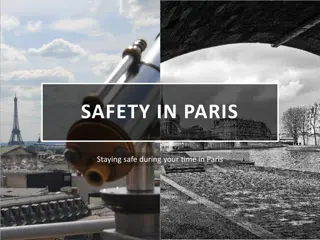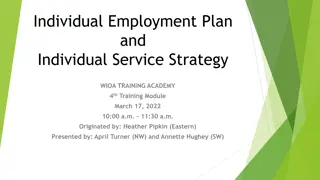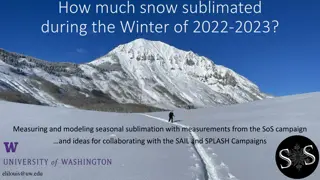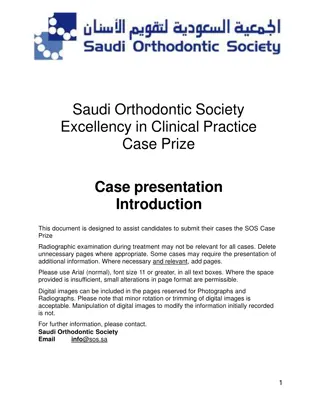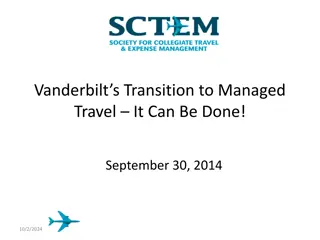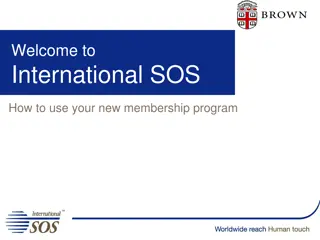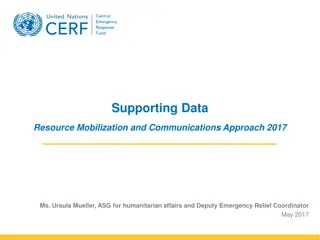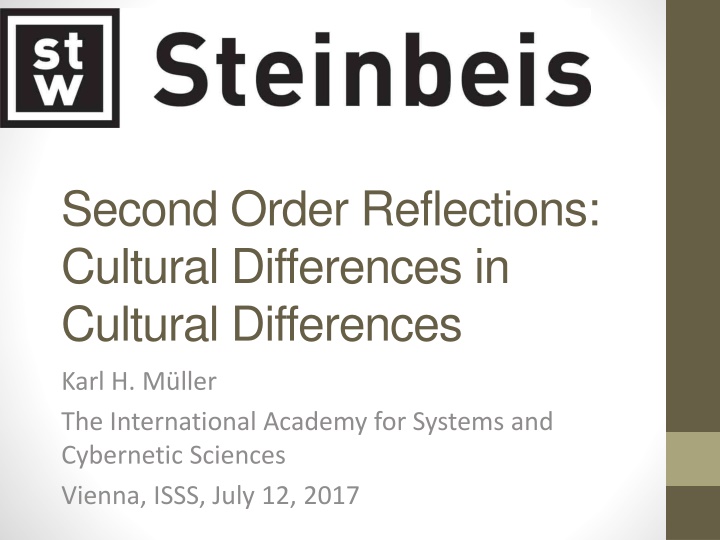
Insights into Cultural Differences and Second-Order Science
Explore the evolution of science, technology, and culture with a focus on second-order science and the potential of reflexivity. Delve into the functional differentiation between levels zero and one in scientific research, and discover the rise of meta-analysis in educational and psychological studies. Gain valuable perspectives on navigating cultural differences and unlocking the potentials of reflexivity in a rapidly changing world.
Download Presentation

Please find below an Image/Link to download the presentation.
The content on the website is provided AS IS for your information and personal use only. It may not be sold, licensed, or shared on other websites without obtaining consent from the author. If you encounter any issues during the download, it is possible that the publisher has removed the file from their server.
You are allowed to download the files provided on this website for personal or commercial use, subject to the condition that they are used lawfully. All files are the property of their respective owners.
The content on the website is provided AS IS for your information and personal use only. It may not be sold, licensed, or shared on other websites without obtaining consent from the author.
E N D
Presentation Transcript
Second Order Reflections: Cultural Differences in Cultural Differences Karl H. M ller The International Academy for Systems and Cybernetic Sciences Vienna, ISSS, July 12, 2017
Overview of Science, Technology, Culture, Society Revolution in Science: Science I (ca.1500 1940/60) Science II (1940/60ff.) Science II: Based on Two Principal Components: Complexity and Reflexivity Hidden Component: Reflexivity Reflexivity on Three Major Pillars: Second-Order Science, Endo-Science, Reflexive Domains
Open Cognitive Horizons in Science, 1940 - 1960
The Rise of Second-Order Science The Emergence of a New Architecture of Science
Functional Differentiation between Levels Zero and One First-Order Science: The Science of Exploring the World Zero-Order Science (Research Infrastructures): A Catalytic Function for First-Order Science; Enabling Research, Speeding-up Research Experimental Data, Data, Information, Documents, etc.
Changes in the Science II-System, 1940/60 - 2017 Gene V. Glass (Educational Scientist): Primary, Secondary and Meta-Analysis of Research , in: Educational Researcher 5, 3 8, 1976 Primary Data Analysis: New Data Secondary Data Analysis: Available Data Meta-Analysis: Pooling of Data; Statistical Analysis of Statistical Analyses Meta-Analysis: the analysis of analysis and as a statistical analysis of a large collection of analysis results from individual studies for the purpose of integrating the findings. It connotes a rigorous alternative to the casual, narrative discussions of research studies which typify our attempts to make sense of the rapidly expanding research literature. (Glass, 1976:3)
Changes in the Science-II System, 1940/60 - 2017 The Rise of Meta-Analysis in Psychological Abstracts Year 1967 1976 1977 1978 1979 1980 1981 1982 1983 1984 Number of Counts 0 2 4 6 9 18 32 55 63 Source: Hunter/Schmidt, 1990:40
Functional Differentiation between Levels One and Two Second-Order Science: A Reflexive Function for First-Order Science: Quality Control [Robustness, Integration, etc.] Innovation [New Themes, New Insights, Deep Structures , etc.] First-Order Science: The Science of Exploring the World
A Correspondence Principle between First and Second-Order Science Fields Correspondence Principle: For every well-developed first-order field or discipline one can construct a corresponding second-order field or discipline Systems Sciences Management Science Sociology X Second-Order Systems Sciences Second-Order Management Sci. Second-Order Sociology Second-Order [X]
Second-Order Science: A Vast and Largely Unexplored Science Frontier Second-order problems can be generated for all types of first-order science building blocks (inputs and outputs): Theoretical Concepts Models Theories Tests Patterns Systems Surveys Distributions Studies, etc.
The Primary Operation for Second-Order Topics: Re-Entries Second-Order Problems through Re-Entries of First- Order Building Blocks: Elements from First-Order Science X X(X) can be a test of tests, a pattern of patterns, a function of functions, a correlation of correlations, a model of models, a design of designs, a concept of concepts, etc.
Basic Differences Between Second- Order Science and Meta-Analyses Meta-Analyses are a Subset of Second-Order Science (Analysis of Analyses, Study of Studies, etc.) Meta-Analyses: Primary Goal in Quality-Control Robustness, Generality, etc. Second-Order Science: Two Goals Goal I : Quality Control, Robustness, Generality, etc. Goal II: Innovations, New Perspectives, New Horizons
The General Methodology for Second- Order Science: P A S T Research in second-order science should be organized in four steps: P-roblem Specification through Re-Entries A-dding and Ordering Relevant Materials from First-Order Science S-tudying, Analyzing, Generalizing, etc. these Materials T-ransferring the Results of Second-Order Investigations to First-Order Science
An Innovative Second-Order ESS- Study of ESS-Studies (X(X)) Focus: European Social Survey (ESS) Currently app. 3000 articles with ESS-Data from 2003 onwards Research Tasks: P-roblem Specification: An ESS-Study of ESS-Studies A-dding and ordering the available first-order ESS-studies S-tudying this data-base and constructing different profiles of ESS- based research: the utilization of ESS-data in all six rounds, the distribution of topics in all six rounds, the profile of European social survey research (by nation, by disciplines, etc.) T-ransferring the Second-Order ESS-Profiles to First-Order Researchers; Additional suggestions for empowering the ESS
Item Usage of the Core-Part of the ESS ITEM USAGE: A, B C CORE PART 250 Trust in people (3 items) 200 Trst in: - Parliament - Legal system - Police - Politicians Religiousness Attending services Happiness Meeting friends L-R scale Life satisfaction 150 Born in country Health 100 50 0
Second-Order ESS-Study as an Innovation Pump New Insights and Perspectives for a Significant Number of Disciplines OUTSIDE of Survey Research: Statisticians (Development of New Methods) Science Policy and Science Policy Analysts ( evidence based ) Methodologists for the Social Sciences and for General Science Science Studies for the Social Sciences Sociologists of Science ( dead topics like mobility research) Further Disciplines like Philosophy of Science, Scientometrics, etc.
Second-OrderScience: Main Drivers Enormous Production of Scientific Articles, Books, Reports, etc. ( New Intransparency ) Inversion of Novelty Wisdom of Crowds (Diversity, Independence, Decentralization, Aggregation (Surowiecki)) Global Availability (Digital Knowledge Base)
Changes in the Science II-System 1940/60 - 2017: Epistemology A Significant Shift in Epistemology: Science from Without Science from Within Exo-Science Endo-Science Science/Objectivity Science/Eigenforms First-Order Cybernetics Second-Order Cybernetics
Changes in the Science II-System 1940/60 - 2017 Heinz von Foerster (1911 2002) He promoted the idea of a New Copernican Revolution in Science as a Revolution in Complexity AND Reflexivity
The Five Most Important Publications by Heinz von Foerster Das Ged chtnis. Eine quantenmechanische Untersuchung [Memory. A Quantum-Mechanical Investigation] (1948) Some Remarks on Changing Populations (1959) Doomsday: Friday, November 13, AD 2026 (1960) Objects: Tokens for Eigenbehaviors (1976) Ethics and Second-Order Cybernetics (1992)
Two Epistemic Modes Heinz von Foerster: Am I an observer who stands outside and looks in as God-Heinz or am I part of the world, a fellow player, a fellow being? (Foerster, 2014:128) Apart or A part
The Exo-Mode and the Endo- Mode Exo-Mode (Science from Without) Endo-Mode (Science from Within) Appearance World and I: separated Schizoid Monological Denotative Describing You say how it is Cogito, ergo sum Function World and I: one Homonoid Dialogical Connotative Creating It is how you say it Cogito, ergo sumus
The Traditional Way of World- Making during Science I Eric Kandel ( Age of Insight ): Scientists make models of elementary features of the world that can be tested and reformulated. These tests rely on removing the subjective biases of the observer and relying on objective measurements and evaluations . (Kandel, 2012:449)
The Traditional Exo-Mode Initial Stage Final Stage
The Endo-Mode (Science from Within) Triadic and Generative Network (Domain of Investigation X, I(Researchers), Knowledge Base), Recursively Organized
Church-Curry Fixed Point Theorem In Generative Triadic Networks ( Reflexive Domains (L.H. Kauffman)): Church-Curry fixed point theorem. Let D be a reflexive domain and let T be any element of the domain D. Then there is an element X in D such that X is a fixed point for T. That is, TX = X. In every operationally closed system there arise Eigenvalues. (Heinz von Foerster)
Examples for Eigenforms Domain: Numbers {1, 2, 3, ., 999} Operation: Extracting the square root (SQRT) Initial Value: Eigenform: D(1,SQRT) = 1 Experiment E, Researchers R, Result of Experiment X: Eigenform: E(R, X) = X
Widening of Problem-Solutions Theoretical or Scientific Problem- Solutions Societal or Practical Problem Solutions Identification of a Scientific Problem; Theoretical Framework Explanation for the Scientific Solution of a Problem Identification of a Societal Problem Plan of Action for the Elimination or Reduction of a Societal Problem
Two Types of Second-Order Second-OrderE (Epistemology) Second-OrderL (Levels, Fields) Mode from Within Second-Order Science Reflexive Domain Second-Order Studies on First-Order Components
First-Order Cybernetics and Second-Order Cybernetics First-Order Cyber netics Second-Order Cyber- netics Cybernetics from Without Cybernetics from within Exo-Cybernetics Endo-Cybernetics Cybernetics of Systems Observed Cybernetics of Observing Systems
Four Science Fields for Each Science Field X within Science II Exo-Mode Endo-Mode First-O. Science Exo-Psychology First-Order X Endo-Psychology Second-Order X Second-O. Second-Order Science Exo-Psychology Sec.Ord.Exo-X Second-Order Endo-Psychology Sec.Ord.Endo-X
The Five-Fold Agenda for Second- Order (Endo-)Cybernetics Agenda I: Building an Alternative General Methodology for Endo-Science Agenda II: Creating Special Endo-Methodologies for Scientific Disciplines Agenda III: Foundations, Reframing, Contextualizations within and across Scientific Disciplines Agenda IV: Reflexive Circles in Applied Domains like Design, Education, Consulting, etc. Agenda V: Reflexive Circles in Artistic Domains (Music, Theater, etc.)
The Five-Fold Agenda of Ranulph Glanville Ranulph Glanville, (1946 2014) The Black B x (3 vol.) Composer, Architect, Designer Professor for Innovation Design, Royal College of Art, London Professor for Research Design, Catholic Uni- versity of Leuven
Changes in the Science II-System 1940/60 - 2017: Domains of Investigations Rise of Reflexivity within the Domains of Investigation: Two Basic Instances Human Communication and Interaction Processes: Internal Organization of Actors: Actors (A, B, C....) and Reflexive Relations like A: B(A)), B: A(B)), etc. Paradigmatic Example: Vladimir A. Lefebrve Two Ethical Systems (System I, System II)
Changes in the Science II-System 1940/60 - 2017: Domains of Investigations Coupled Complex Micro-Macro Ensembles Micro-Actors: {a, b, c ...} Micro-Actions (pa, pb, pc..} S, X .. Macro-Factors Paradigmatic Example: George Soros, Reflexivity Theory and Financial Markets
Science II as the Second Copernican Revolution in Science Complexity Revolution A Large Number of Science Dimensions Exhibits Center-Periphery Relations; Exchange between Center-Periphery Relations (e.g., Linear/Non-Linear); Shifts towards Higher Complexity Levels Reflexivity Revolution Second-Order Science, Endo-Science, Reflexive Domains as Major Backbone
Closing Aphorisms I: First-Order Science: The Science of Exploring the World Second-Order Science: The Science of Reflecting on these Explorations
Closing Aphorisms II: Exo-Science: Exploring the World and Reflecting on these Explorations from Outside Endo-Science: Exploring the World and Reflecting on these Explorations from Within
Closing Aphorisms III: In Science II, each scientific domain or discipline X can be developed in four different ways, namely as first-order exo-X, first-order endo-X, second-order exo-X and as second-order endo X First-order science and second-order science operate as dual and recursively closed systems on themselves (like a sensorium and a motorium)
The Second Copernican Revolution Heinz von Foerster (1911 2002) He promoted the idea of a New Copernican Revolution in Science as a Revolution in Complexity AND Reflexivity
Literature Karl H. M ller. Alexander Riegler (2014), Second- Order Science: A Vast and Largely Unexplored Science Frontier , in: Constructivist Foundations, Vol. 10, No. 1, 7 15 Karl H. M ller (2014), Towards a General Methodology for Second-Order Science , in: Journal of Systemics, Cybernetics and Informatics 12, No. 5, 33 - 42 M ller, K.H., Riegler, A. (2016), Mapping the Varieties of Second-Order Cybernetics , in: Riegler, A., M ller K.H. (eds.) Constructivist Foundations, Vol. 11, No. 3, 443 - 454
Literature (Continued) Karl H. M ller (2016), Second-Order Science. The Revolution of Scientific Structures. Wien:edition echoraum Karl H. M ller (2015), A Silent Revolution in Reflexivity , in: Journal of Systemics, Cybernetics and Informatics , Vol. 13, No. 6, 70 - 81 Karl H. M ller (2015), The Multiple Faces of Reflexive Research Designs , in: Systemics, Cybernetics and Informatics 12, Vol. 13, No. 6, 87 - 98
Literature (Continued) Brina Malnar, Karl H. M ller (2015), Surveys and Reflexivity. A Second-Order Study of the European Social Survey (ESS). Wien:edition echoraum M ller, Karl H. (2015), De Profundis. Ranulph Glanville s Transcendental Framework for Second- order Cybernetics , in: Cybernetics and Human Knowing, Vol. 22, Nos. 2 3, 27 47 M ller, Karl H. (2017), An Outline of the Varieties of the Second-Order Systems Sciences , in preparation
Literature (Continued) Hollingsworth, J.R., M ller, K.H. (2008), Transforming Socio-Economics with a New Epistemology , in: Socio- Economic Review, no. 3, vol. 6, 395 426 M ller, K.H., To , N. (2012), Towards a New Kind of Social Science. Social Research in the Context of Science II and RISC-Societies. Wien:edition echoraum Foerster, H.v. (2014), The Beginning of Heaven and Earth Has No Name. Seven Days with Second-Order Cybernetics, ed. by M ller, A. and M ller, K.H. New York:Fordham University Press
Contact: Karl H. M ller Steinbeis Transfer Center New Cybernetics Vienna, Austria khm@chello.at 0043 664 4191961
Prepared for a workshop on The Influence of History and Culture on Science and Philosophy At the annual meeting of the International Society for the Systems Sciences Technical University of Vienna Vienna, Austria 12 April, 2017


![❤Book⚡[PDF]✔ Doing the Impossible: George E. Mueller and the Management of NASA’](/thumb/21684/book-pdf-doing-the-impossible-george-e-mueller-and-the-management-of-nasa.jpg)
